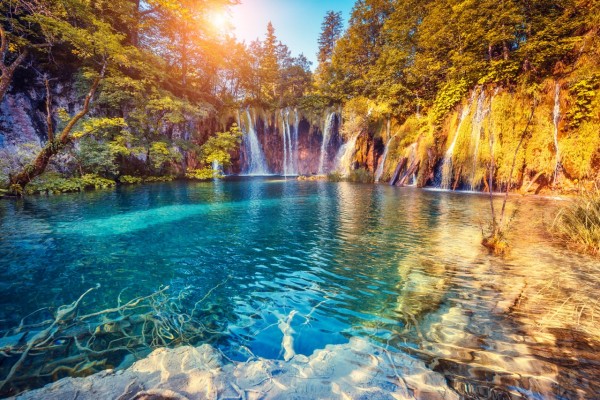How to Get from Zagreb to Split via Plitvice Lakes
Croatia is a popular tourist destination, attracting visitors from all over the world to explore its stunning landscapes, historic cities like Zagreb and Split, and the breathtaking natural wonders such as Plitvice Lakes. If you're planning a visit to Croatia, a highly recommended itinerary is traveling from Zagreb to Split while stopping at the mesmerizing Plitvice Lakes - a destination you won't want to miss on your journey through this beautiful country.
Zagreb, the capital of Croatia, offers numerous cultural and historical attractions, while also serving as a great starting point for your adventure. The journey from Zagreb to Split is scenic and provides various options to reach the captivating Plitvice Lakes National Park. This UNESCO World Heritage Site is renowned for its cascading waterfalls, turquoise lakes, and diverse flora and fauna, making it a must-see attraction when exploring Croatia.
In this guide, you'll learn the different ways to get from Zagreb to Split via Plitvice Lakes, ensuring that your journey is as enjoyable and efficient as possible. Whether you prefer traveling by car, bus, or a combination of transportation methods, this informative guide will help you make the most of your Croatian adventure. Enjoy the stunning beauty of Plitvice Lakes and let this unforgettable experience become an essential part of your journey from Zagreb to Split.
Planning the Route from Zagreb to Split
Best Times to Travel
Traveling from Zagreb to Split via Plitvice Lakes can be a beautiful and memorable experience any time of the year. However, it's worth noting that the best times to visit Plitvice Lakes are during spring and early autumn. During these times, temperatures are comfortable, and the tourist crowds in Plitvice Lakes National Park are less intense.
Road Tolls
The most popular way to travel from Zagreb to Split via Plitvice Lakes is by car. Croatia has a well-maintained network of highways, and tolls are collected using an electronic reader system. When you enter the highway, you will receive a ticket, and when you exit, you will pay the toll based on the distance you've traveled. The cost of tolls for the journey can range from €20 to €30. For up-to-date road toll prices, it's recommended to visit an official Croatian Toll provider.
Key Locations along the Route
Starting in Zagreb, you'll travel south on the D1 road for about 2 hours before reaching Plitvice Lakes National Park. The park is a UNESCO World Heritage site, and it's famous for its stunning lakes, cascading waterfalls, and network of wooden walking trails. Your visit to the park should take 3-4 hours, but you should consider staying in the park overnight if you have time.
After Plitvice Lakes, continue south on the D1 road towards Split. About 40 minutes into your drive, you will enter the highway again at the "Gornja Ploca" entrance1. Traveling on the highway for about 3 hours, you'll take the "Dugopolje" exit, driving to your final destination of Split. Overall, the journey from Zagreb to Split via Plitvice Lakes will take approximately 5 hours of driving time, not including sightseeing and breaks.
Private Transfer from Zagreb to Split via Plitvice Lakes
By far the most convenient, comfortable and time efficient way to make this journey is by private transfer.

With this door-to-door service you have your own vehicle, you determine the time you would like to start the transfer and how long you would like to spend in the park. It is a seamless and enjoyable experience. Click here for a quote for this service. Prices start at 475 Euro.
Taking the Bus from Zagreb to Split
One popular option to get from Zagreb to Split via Plitvice Lakes is by taking the bus. There are multiple bus routes available with different durations, ranging from 2 hours and 11 minutes to 3 hours and 31 minutes. This is an affordable option with prices varying from €11 to €52, depending on the bus route and company.
Taking the Train from Zagreb to Split
While there is no direct train from Zagreb to Split via Plitvice Lakes, travelers can consider combining train and bus services to cover the journey. This combination of train and bus takes around 3 hours and 31 minutes, and costs between €51 and €52. However, it's essential to plan the schedule carefully, as the connections are poor.
Exploring the Plitvice Lakes National Park
Plitvice Lakes Entrance Tickets
Plitvice Lakes National Park has an e-ticket system where it is advised that you purchase your tickets at least 48 hours in advance of your planned visit. This was introduced to control the number of visitors to the park to preserve the National Park. It is very important if you are visiting in May-October that you purchase your tickets from the online system, you can get them here, as there is a good chance that you will not be able to enter the park when you arrive as all the entrance slots will be sold. Especially if you arrive between 11:00-13:00 which are the peak entry period into the park.
Natural Wonders of Plitvice
Plitvice Lakes National Park is a unique destination featuring a breathtaking complex of waterfalls, cascades, and lakes. In addition to the beautiful bodies of water, the park is home to the mesmerizing emerald-green color of the lakes. In total, the park contains 16 lakes, divided into upper and lower lakes. The highest waterfall present in the park is the aptly named "Large Waterfall," which has a height of around 78 meters.
History of the Park
The history of Plitvice Lakes dates back thousands of years, and the park itself has been a protected natural reserve since the 1940s. In 1979, the park was inscribed on the UNESCO World Heritage List due to its outstanding geological and ecological value. This recognition has helped to preserve the park and promote sustainable tourism in the area.
Hiking in the Park
Hiking is one of the most popular activities in Plitvice Lakes National Park, and there are numerous well-marked trails catering to various levels of difficulty. Visitors can opt for guided hikes or explore the park at their own pace. Most trails start at either Entrance 1 or Entrance 2, and some popular hikes include:
Lower Lakes Loop: A relatively easy 3-hour hike showcasing some of the park's most beautiful waterfalls and cascades.
Upper Lakes Loop: A more challenging 6-hour hike that traverses the stunning upper lakes and culminates in panoramic views of the park.
You can get the detailed trail information from the Plitvice Lakes Website. If you are on a day trip to the park then we recommend taking the lower lakes hikes which last 3-4 hours. If you have a bit more time then we recommend taking in both the upper and lower lakes. Have a look at trails C & H for the upper lakes and A & E for the lower lakes.
How much time do you need to spend at Plitvice Lakes?
This all depends on how keen of a hiker you are? To see the main attractions 3-4 hours is more than enough time. If you are an avid hiker and then perhaps 6-8 hours.
Where should you stop when traveling from Zagreb to Split via Plitvice Lakes?
Between Zagreb and Plitvice Lakes the best place to stop is Rastoke Watermill village. Located on the Slunjcica river, Rastoke is a small little village with small waterfalls, and watermills and makes for outstanding photo stop.

If you would like to learn a liitle about the Homeland war then consider a stop at the Museum of the Homeland War in Turanj, which is a short distance outside of Karlovac.

Here you will find a great collection of military equipment that was used during the war and also many displays and information on the war itself. The best part of the museum are the tanks, militray vehicles and various guns on display outside the museum building.
Between Plitvice Lakes and Split you have quite a few more options for stops, if you still have any energy left. Lets start with the cities of Zadar, Sibenik and Trogir. These are all your typical Dalmatian cities that have very long histories and with lots of sites and things to keep you entertained.

Lastly, you also have another 2 National Parks the first being Starigrad-Paklenica National Park. This National Park is famous for rock climbing, expecially in its canyon, and also hiking. This park is definitely for more advanced hikers with steeper terrain. The 2nd National Park is Krka Waterfalls which as the name suggest is also famous for waterfalls like Plitvice Lakes.

In conculsion, by far the best option for travel between Zagreb and Split is to take a private transfer. It is the fastest and most comfortable way to travel and you can take in extra sites along the way should you choose to.


